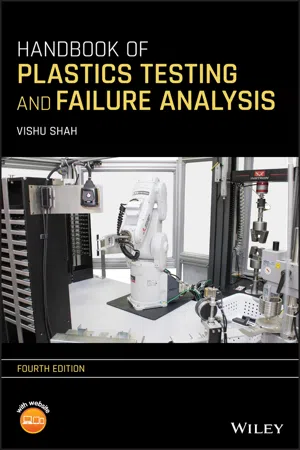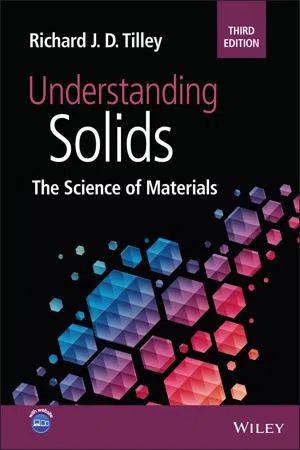Technology & Engineering
Temperature Dependent Properties
Temperature dependent properties refer to physical and chemical characteristics of materials that change with variations in temperature. These properties can include thermal expansion, electrical conductivity, and magnetic susceptibility. Understanding how these properties are affected by temperature is crucial in the design and performance of various engineering materials and devices.
Written by Perlego with AI-assistance
Related key terms
Related key terms
1 of 4
Related key terms
1 of 3
6 Key excerpts on "Temperature Dependent Properties"
- eBook - ePub
- Jerry C. Whitaker(Author)
- 2018(Publication Date)
- CRC Press(Publisher)
2 Thermal Properties David F. Besch 2.1 Introduction 2.2 Fundamentals of HeatTemperature • Heat Capacity • Specific Heat • Thermal Conductivity • Thermal Expansion • Solids • Liquids • Gases2.3 Other Material PropertiesInsulators • Dielectric Constant • Resistivity • Semiconductors • Conductors • Melting Point2.4 Engineering DataTemperature Coefficient of Capacitance • Temperature Coefficient of Resistance • Temperature Compensation2.1 IntroductionThe rating of an electronic or electrical device depends on the capability of the device to dissipate heat. As miniaturization continues, engineers are more concerned about heat dissipation and the change in properties of the device and its material makeup with respect to temperature.The following section focuses on heat and its result. Materials may be categorized in a number of different ways. In this chapter, materials will be organized in the general classifications according to their resistivities:• Insulators • Semiconductors • ConductorsIt is understood that with this breakdown, some materials will fit naturally into more than one category. Ceramics, for example, are insulators, yet with alloying of various other elements, can be classified as semiconductors, resistors, a form of conductor, and even conductors. Although, in general, the change in resistivity with respect to temperature of a material is of interest to all, the design engineer is more concerned with how much a resistor changes with temperature and if the change drives the circuit parameters out of specification.2.2 Fundamentals of HeatIn the commonly used model for materials, heat is a form of energy associated with the position and motion of the material’s molecules, atoms, and ions. The position is analogous with the state of the material and is potential energy, whereas the motion of the molecules, atoms, and ions is kinetic energy. Heat added to a material makes it hotter and vice versa. Heat also can melt a solid into a liquid and convert liquids into gases, both changes of state. Heat energy is measured in calories (cal), British thermal units (Btu), or joules (J). A calorie is the amount of energy required to raise the temperature of one gram (1 g) of water one degree Celsius (1°C) (14.5 to 15.5°C). A Btu is a unit of energy necessary to raise the temperature of one pound (1 lb) of water by one degree Fahrenheit (1°F). A joule is an equivalent amount of energy equal to work done when a force of one newton (1 N) acts through a distance of one meter (1 m). Thus heat energy can be turned into mechanical energy to do work. The relationship among the three measures is: 1 Btu = 251.996 cal = 1054.8 J. - eBook - ePub
- Jerry C. Whitaker, Jerry C. Whitaker, Richard C. Dorf(Authors)
- 2017(Publication Date)
- CRC Press(Publisher)
4Thermal Properties
David F. Besch University of the Pacific4.1 Introduction 4.2 Fundamentals of Heat Temperature Heat Capacity Specific Heat Thermal Conductivity Thermal Expansion Solids Liquids Gases 4.3 Other Material Properties Insulators Semiconductors Conductors Melting Point 4.4 Engineering Data Temperature Coefficient of Capacitance Temperature Coefficient of Resistance Temperature Compensation4.1 Introduction
The rating of an electronic or electrical device depends on the capability of the device to dissipate heat. As miniaturization continues, engineers are more concerned about heat dissipation and the change in properties of the device and its material makeup with respect to temperature.The following section focuses on heat and its result. Materials may be categorized in a number of different ways. In this chapter, materials will be organized in the general classifications according to their resistivities:- Insulators
- Semiconductors
- Conductors
It is understood that with this breakdown, some materials will fit naturally into more than one category. Ceramics, for example, are insulators, yet with alloying of various other elements, can be classified as semiconductors, resistors, a form of conductor, and even conductors. Although, in general, the change in resistivity with respect to temperature of a material is of interest to all, the design engineer is more concerned with how much a resistor changes with temperature and if the change will drive the circuit parameters out of specification.4.2 Fundamentals of Heat
In the commonly used model for materials, heat is a form of energy associated with the position and motion of the material’s molecules, atoms and ions. The position is analogous with the state of the material and is potential energy, whereas the motion of the molecules, atoms, and ions is kinetic energy. Heat added to a material makes it hotter and vice versa. Heat also can melt a solid into a liquid and convert liquids into gases, both changes of state. Heat energy is measured in calories (cal), British thermal units (Btu), or joules (J). A calorie is the amount of energy required to raise the temperature of one gram (1 g) of water one degree Celsius (1°C) (14.5 to 15.5°C). A Btu is a unit of energy necessary to raise the temperature of one pound (1 lb) of water by one degree Fahrenheit (1°F). A joule is an equivalent amount of energy equal to work done when a force of one newton (1 N) acts through a distance of one meter (1 m). Thus heat energy can be turned into mechanical energy to do work. The relationship among the three measures is: 1 Btu = 251.996 cal = 1054.8 J. - eBook - ePub
Material Selection for Thermoplastic Parts
Practical and Advanced Information
- Michel Biron(Author)
- 2015(Publication Date)
- William Andrew(Publisher)
Of course, following data are only examples providing a rough idea of the significant differences between subfamilies but other data can be found elsewhere. These theoretical data cannot be used for designing, computing, or to make economic predictions. Only properties measured on the actual used compound must be considered.8.1. Overview
A temperature rise causes two different phenomena:• Immediate physical effects:• Decay of the modulus and other mechanical and physical properties, physicochemical softening.• Dimensional stability: reversible thermal expansion and, eventually, irreversible shrinkage and warpage.• Long-term effects:The maximum service temperatures depend on the duration of service time and the possible simultaneous application of mechanical or other stresses. A fall in temperature has only physical effects: • Increase in the modulus and rigidity. • Reduction in the impact resistance; the material can become brittle. • Eventually, crystallization for semicrystalline polymers.• Physical: more or less irreversible creep and relaxation.• Chemical: irreversible degradation of the material, decrease in the mechanical properties, even after a return to ambient temperature.Immediate effects of high and low temperatures on engineering mechanical properties are examined in Chapter 10 .8.2. Glass Transition Temperature (See Also Section 2.3.3 )
For amorphous polymers or amorphous domains of semicrystalline polymers, the glass transition temperature (Tg) is a reversible transition from a hard and brittle state into a molten or rubber-like state. Designers must be aware of abrupt evolutions of some properties when temperature overcomes the glass transition temperature. The transition temperature value depends on the testing conditions, notably the cooling or heating rate and the frequency of the measured parameter. - Vishu Shah(Author)
- 2020(Publication Date)
- Wiley(Publisher)
3 THERMAL PROPERTIES3.1. INTRODUCTION
The thermal properties of plastic materials are equally as important as the mechanical properties. Unlike metals, plastics are extremely sensitive to changes in temperature. The mechanical, electrical, or chemical properties of plastics cannot be examined without looking at the temperature at which the values were derived. Crystallinity has a number of important effects upon the thermal properties of a polymer. Its most general effects are the introduction of a sharp melting point and the stiffening of thermal mechanical properties. Amorphous plastics, in contrast, have a gradual softening range (1 ). Molecular orientation also has a significant effect on thermal properties. Orientation tends to decrease dimensional stability at higher temperatures (2 ). The molecular weight of the polymer affects the low‐temperature flexibility and brittleness. Many other factors, such as intermolecular bonding, cross‐linking, and copolymerization, all have a considerable effect on thermal properties. Hence, it is clear that the thermal behavior of polymeric materials is rather complex. Therefore, in designing a plastic part or selecting a plastic material from the available thermal property data, one must thoroughly understand the short‐term as well as the long‐term effects of temperature on the properties of that plastic material.3.2. TESTS FOR ELEVATED TEMPERATURE PERFORMANCE
Designers and material selectors of plastic products constantly face the challenge of selecting a suitable plastic for elevated temperature performance. The difficulty arises because of the varying nature and capabilities of various types and grades of plastics at elevated temperatures. Many factors are considered when selecting a plastic for a high‐temperature application. The material must be able to support a design load under operating conditions without objectionable creep or distortion. The material must not degrade or lose necessary additives that will cause a drastic reduction in the physical properties during the expected service life.- eBook - ePub
- Maria Rosa Aguilar, Julio San Román(Authors)
- 2019(Publication Date)
- Woodhead Publishing(Publisher)
Chapter 2Temperature-Responsive Polymers: Properties, Synthesis, and Applications
Richard Hoogenboom Supramolecular Chemistry group, Centre of Macromolecular Chemistry (CMaC), Department of Organic Chemistry, Ghent University, Ghent, BelgiumAbstract
This chapter describes polymers that undergo a temperature-induced phase transition in aqueous solution, which provides an important basis for smart materials. The basic principles of the upper and lower critical temperature polymer phase transitions will be discussed as well as key types of such temperature-responsive polymers and selected potential applications.Keywords
LCST; Phase transition; Responsive polymer; Smart material; UCST2.1 Introduction: The Role of Temperature-Responsive Polymers
Smart materials that respond with a property change to a change in the environmental conditions are an attractive class of materials for advanced applications. Responsive and adaptive materials are also omnipresent in natural systems. Examples include the focusing of the eye, the opening and closing of pores, as well as wound healing (Stryer, 1999 ). The majority of such natural responsive and adaptive processes are driven by conformational changes and/or aggregation of proteins, which can be regarded as nature's smart polymers. Similarly, responsive synthetic polymers are attractive building blocks for the development of artificial smart materials. A wide variety of responsive polymer materials have been reported that respond to various external parameters, such as temperature, pH, mechanical stress, and even certain molecules, including CO2 and sugars (see Roy et al., 2010 ; Wei et al., 2017 for recent reviews). The response of the polymer can also be manifold, such as a change in shape, color, or solubility.Temperature-responsive polymers are especially interesting because variations in temperature can be applied externally in a noninvasive manner. Furthermore, spontaneous temperature fluctuations also occur in nature, for example, during day and night cycles as well as the increased temperature of inflamed tissue. - eBook - ePub
Understanding Solids
The Science of Materials
- Richard J. D. Tilley(Author)
- 2021(Publication Date)
- Wiley(Publisher)
13 Thermal Properties of Solids- Why are metals poor thermal insulators?
- What materials show thermal contraction not thermal expansion?
- How does a thermocouple work?
In a normal solid the component atoms are in constant motion and the vibrations constitute the thermal energy of the material. The way in which materials respond to changes in thermal energy forms the subject of thermodynamics. Although an account of the formal structure of thermodynamics is beyond the scope of this chapter, a number of more general physical properties allied to changes in thermal energy are described.13.1 Heat Capacity
13.1.1 The Heat Capacity of a Solid
The heat capacity of a solid quantifies the relationship between the temperature of a body and the energy supplied to it. If a large amount of heat supplied to a body produces only a small temperature increase, the solid has a large heat capacity, formally defined by:where ΔQ is the amount of heat (energy) needed to produce a temperature change ΔT so that C, the heat capacity, represents the amount of heat required to raise the temperature of the sample by 1 °K. The heat capacity is frequently quoted as the molar heat capacity; the amount of heat that increases the temperature of 1 mol of substance by 1°, units J mol−1 K−1 , or the specific heat capacity, the amount of heat that increases the temperature of 1 g of a substance by 1°, units J g−1 K−1 .The heat capacity is found to depend upon whether the measurement is made at constant volume, Cv , or at constant pressure, Cp . For solids, the difference between Cp and Cv is very small at room temperature and below. Most experimental studies on materials are made at atmospheric pressure and Cp values are of most relevance (Table 13.1 ). The heat capacity of a solid generally increases with temperature. Empirically Cp can be fitted to an equation of the form:where a, b, c, d, and e are constants. For example, the heat capacity of Al2 O3
Index pages curate the most relevant extracts from our library of academic textbooks. They’ve been created using an in-house natural language model (NLM), each adding context and meaning to key research topics.
Explore more topic indexes
Explore more topic indexes
1 of 6
Explore more topic indexes
1 of 4





